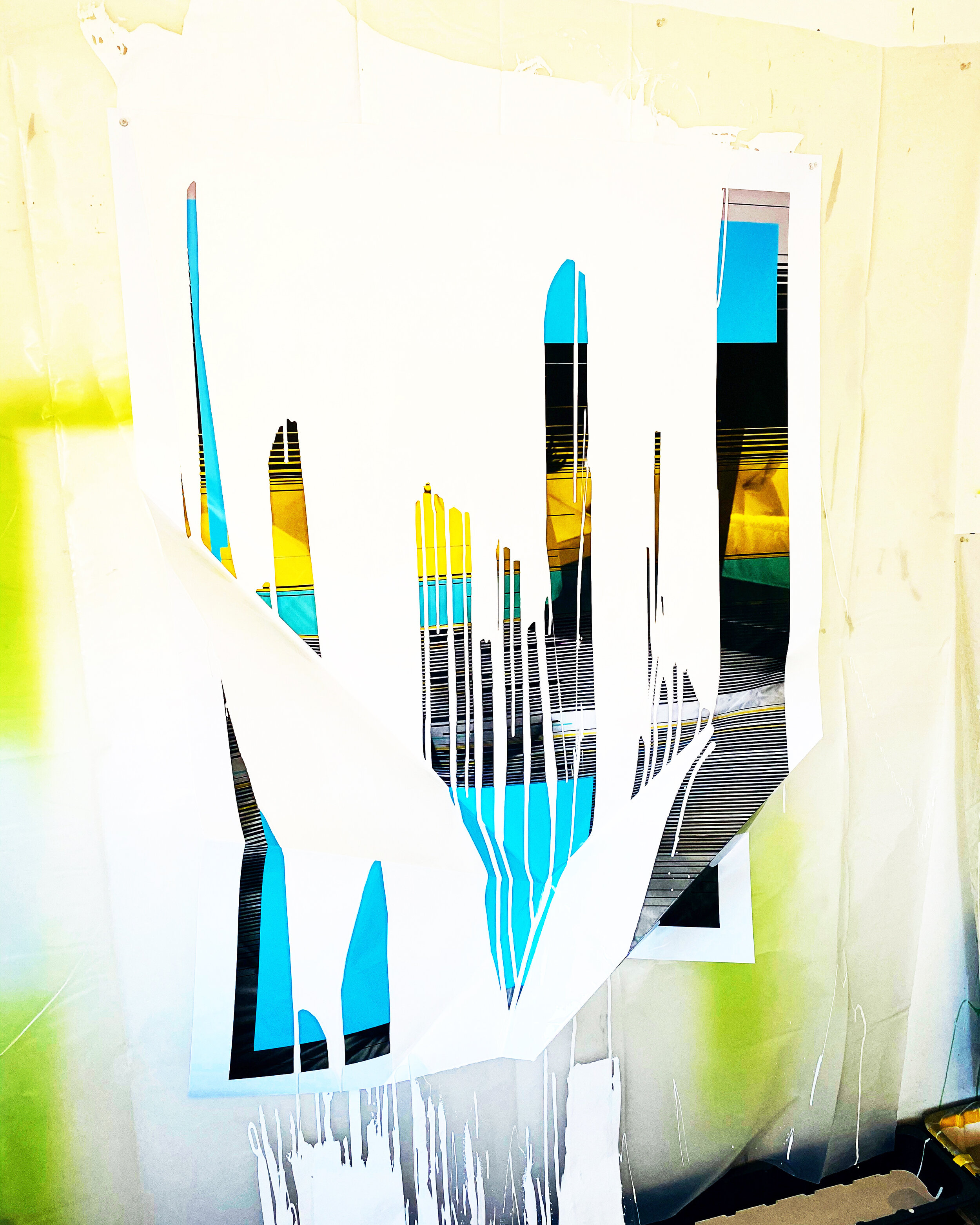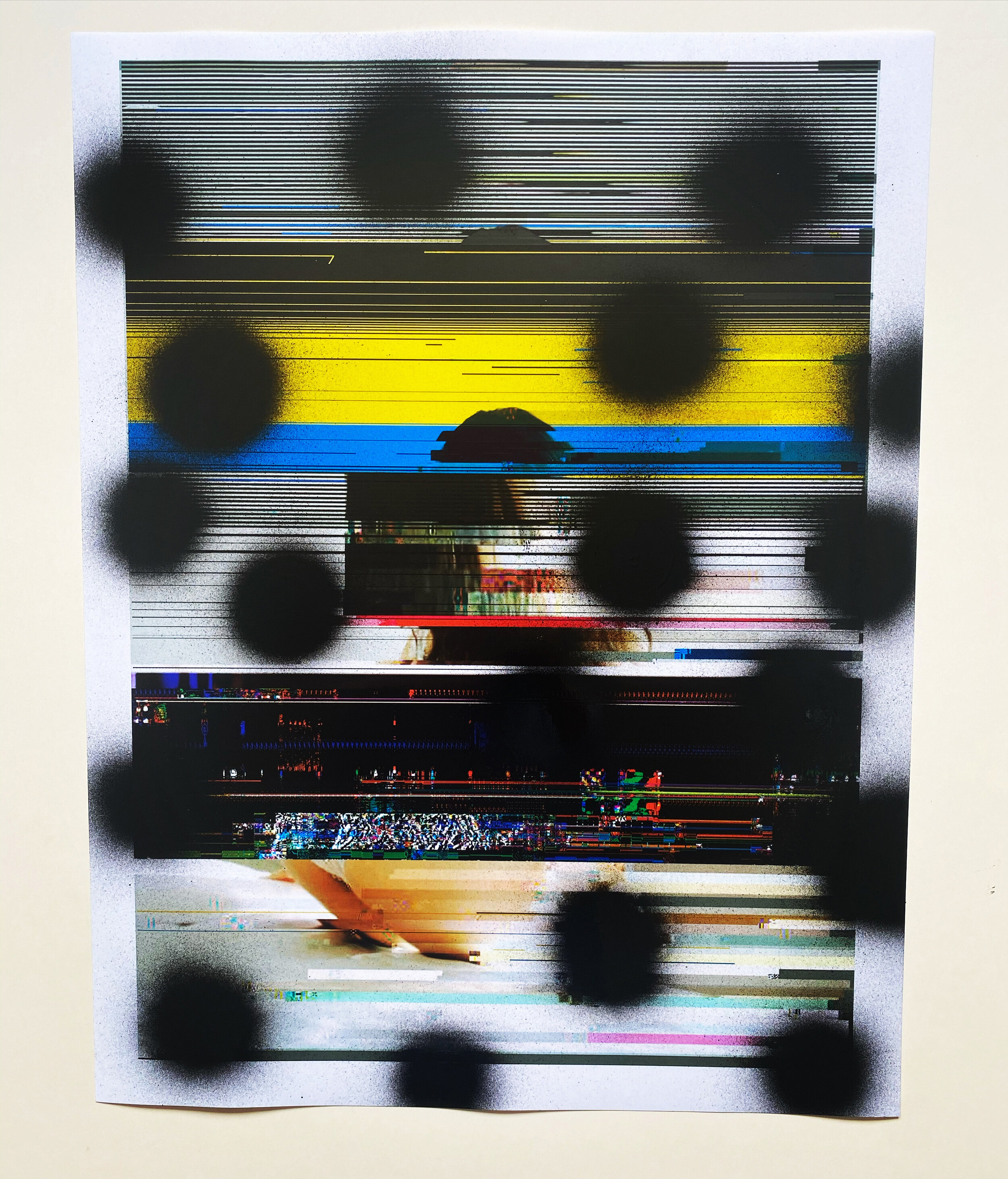john pomara in conversation
with executive director peter doroshenko
What films do you identify with in relationship to your paintings and digital prints?
I still think often of the effect that the films of Wong Kar-Wai had on my work going back to 2002 to present. He did such films as Fallen Angel, 2046, Chungking Express and In the Mood for Love. I found he cinematography in his early films, such as Fallen Angel is really interesting in how he’ll slow down the film in places or speed it back up, and also use color saturation creating a glitchy psychedelic quality in certain scenes.
Also early Godard films like Contempt. That scene where Brigit Bardot is lying nude on the sofa is saturated in red. Then years later it is appropriated in the great innovative film by Tom Tykwer, Run Lola Run. Godard experimented with various distortion aspects like jump cuts, and pivoting camera rotation with the cinematography as well as sound disruptions. In a way he distorted and glitched moments in the film to create dramatic effects. Those things have influenced my work.
I really follow films that deal with a nonlinear narrative. Movies such as Memento, Eternal Sunshine of a Spotless Mind, Run Lola Run, and Timecode. My list goes on and on. I even taught a class one semester on films, texts, videos and paintings that dealt with ideas of non-linear and structure manipulation. I realize that it is in all my work.
How do you define digital manipulations and glitches?
I see it as an aesthetic form of creative disruption. Technically glitch is the result of an error. It’s the visual manifestation of an error caused by various factors through the use of technology. Computers, printers, etc… It creates a visual alternative from what is expected. Like a chance effect. It disrupts the form or alters it in an unexpected way that makes it new fresh and alive as if it altered itself on its own.
I discovered years ago in a book I read entitled, Chance Aesthetics, that some of he first artist to pursue chance in various creative aspects were Duchamp and Arp in their intellectual maneuvers and strategies. When computers began being part of culture in the 90’’s glitch entered the vocabulary of artists incorporating the computer in their work.
How would your work change if the internet permanently stopped working?
Now that’s a great question! I don’t know if I can accurately answer that but I know it would eventually change things. At first I would most likely still continue glitching and distorting images into abstraction in ways I use now myself with forms of data-mashing, which is altering the text codes of images. I would also still reprint multiple images one on top of another. I realize I use multiple forms of distortion in my creative practice from disrupting paint application onto the surfaces of aluminum, to printing glich forms from my archives onto other image sources, to altering the code of an image itself to allow an error.
John Pomara, Glitched Nude/Flower 2, 2020, ink on glossy photo paper
John Pomara, Glitched Nude/Paint, 2020, ink on glossy photo paper
John Pomara, Glitched Photo/Paint 2, 2020, ink/oil enamel on photo paper
John Pomara, Sky-Pilot_1, 2020, oil enamel on aluminum
John Pomara, Tru-Blu, 2019, ink and oil enamel on canvas
John Pomara, Glitched Nude 2, 2020, ink on glossy photo paper
John Pomara, Glitched Nude/Flower 3, 2020, ink on glossy photo paper
John Pomara, Glitched Photo/Paint 3, 2020, ink/oil enamel on photo paper
John Pomara, Sunshine on Your Love, 2019, ink and oil enamel on canvas
John Pomara, Sky-Pilot_3, 2020, oil enamel on aluminum
about john pomara
In 2006 and 2007, Pomara had solo exhibitions at the Barry Whistler Gallery in Dallas, Texas, as well as being included in an exhibition at the Dallas Museum of Art titled, Capturing Motion. In 2005, he received the Legends Award from the Dallas Center of Contemporary Art coinciding with a Fifteen Year Survey of his paintings and digital pictures. He has also exhibited his work and has lectured at the Dallas Museum of Art in a solo exhibition; Concentrations 39 and the group show Crossing State Lines, at the Museum of Fine Arts, Houston, with work being acquired for their permanent collection. He has shown extensively in solo and group exhibitions in New York, Chicago, Houston, Miami, Los Angeles and London. Most recently Pomara’s art work has been shown at the Tucson Museum of Art, Arizona, in the exhibition, Paint on Metal, and at the Meadows Museum, Dallas in Texas Vision: The Barrett Collection. He has given lectures and appeared on panels at the Smart Museum, Chicago; the Dallas Museum of Art, Texas; the Nelson-Atkins Museum, Kansas City, Missouri; the McKinney Avenue Contemporary, Dallas; and various universities. His work has been written about critically in major art journals and magazines such as Flash Art, ARTFORUM, and Art in America, Art News, Art Papers and The New Art Examiner.
Pomara has taught as a visiting artist and lecturer at the University of North Texas, East Texas State University, and Brookhaven College. He was awarded the University of Texas Chancellor's Teaching Award in the spring of 2007










